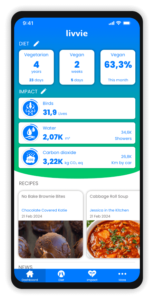Why Eating More Vegan Is Key to Lower Your Water Footprint
Published 16 October 2023
Water is essential for life and a healthy global ecosystem, but it is a finite resource that is already under pressure due to overuse, pollution, and climate change. Water scarcity is one of the biggest environmental and survival challenges we face today.
Our food system is the main consumer of fresh water with a particularly high footprint of animal agriculture. From this article, you will learn why the water footprint of meat and other animal food products is high and how a vegetarian or vegan diet lowers your water use.
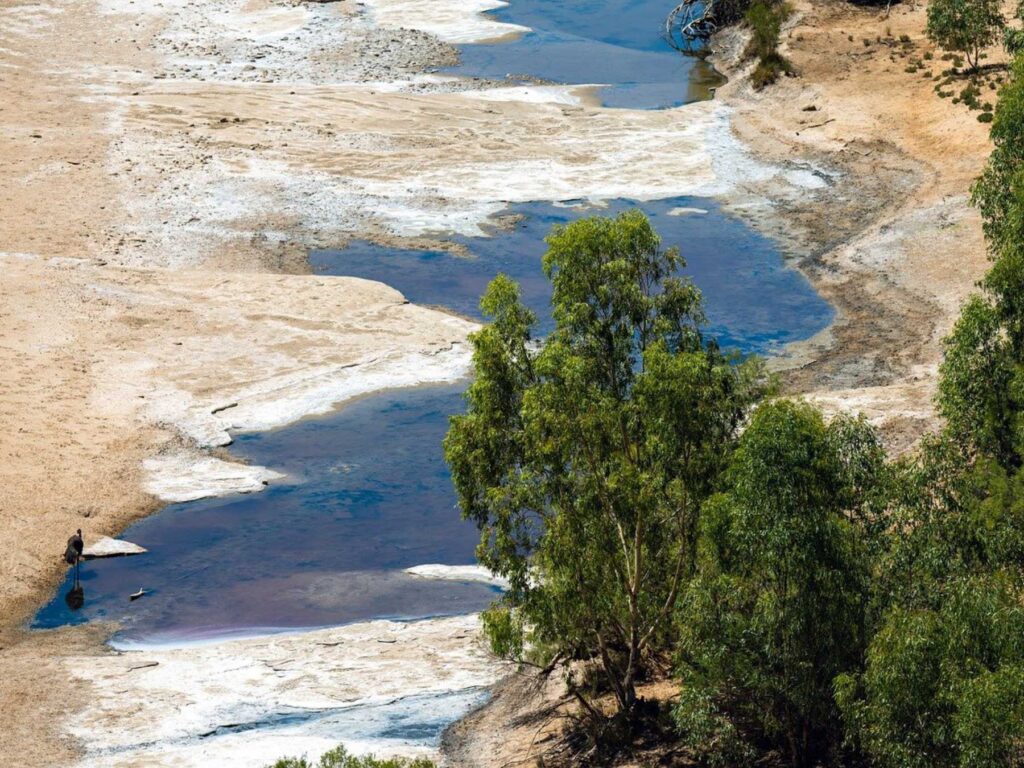
Track how much water you save with your diet in the Livvie app
Why Water Conservation Is Important
Fresh water availability is limited
Water is essential for all life and the global water crisis is one of our biggest global challenges.
Earth’s surface consists for 71% of water, but only 3% of that is fresh water. Most fresh water exists as ground water or frozen in glaciers or ice caps, so only a small portion is accessible for consumption or use in industry or agriculture.
Fresh water is continuously produced through a water cycle of evaporation and precipitation. However, the rate at which rainfall and melting of snow and ice reservoirs replenishes rivers, lakes, and groundwater is limited. So, although renewable, we need to consider fresh water as a finite natural resource.
Unfortunately, we currently exploit and disrupt freshwater resources beyond their capacity to sustain us and the environment.
Water scarcity has severe consequences
Water scarcity is not merely a concern for the future and already affects us today. You may notice the frequent mention of droughts, water shortages and the term ‘water crisis’ in the news.
Access to fresh water is a basic human right, essential for our health and livelihoods. Still, around 2 billion people don’t have access to safe drinking water and half of the world population faces water scarcity. Limited access to clean water can cause dehydration and increase risk of infectious diseases through contaminated water or lacking sanitation.
Besides the need for clean drinking water, our food system depends on water to grow crops for food and livestock feed. Agriculture is responsible for around 70% of all freshwater withdrawals today. Droughts are a big threat to crop yield and hence food security, especially in developing countries. Today, already 2,3 billion people face food insecurity and 9 million people die from hunger every year.
Depletion of freshwater resources has a massive impact on the environment and wildlife. Additionally, droughts increase the risk of wildfires which have caused 30% of all deforestation in the past decade, with detrimental consequences for biodiversity.
Water scarcity is also driving geopolitical conflicts. Countries who have upstream access to freshwater sources can build infrastructure such as dams to retain water. Interrupting natural water flow can have devastating environmental, economic, and societal consequences for downstream countries who depend on that water supply.
Predictions state that 700 million people could have to migrate due to droughts by 2030. These numbers will only rise as the population grows and climate change is getting more severe.
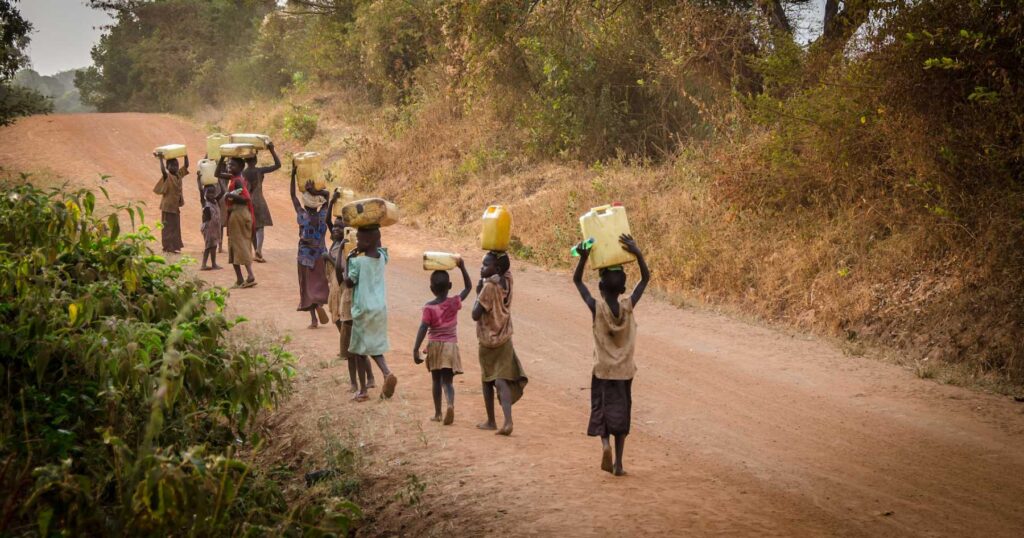
What Is a Water Footprint?
Because water is such a vital resource for the environment and human well-being, it is important to understand how much water we use.
As a consumer, you only see the water you use for drinking, showering, the dishes, and other household routines. But water is also used during the production of other goods and services that you consume.
The water footprint measures the volume of freshwater consumption across the supply chain of products, including food. It considers the amount of water used for irrigation, farming, energy generation, and other industrial processes.
The water footprint of a product consists of three components: green, blue, and grey water.
- Green water represents rainwater that is captured in soils and consumed by plants.
- Blue water is the water that is withdrawn from water resources such as rivers, lakes, and groundwater reservoirs for irrigation or other purposes.
- Grey water refers to pollution and represents the amount of fresh water that is required to dilute pollutants to acceptable levels.
Why Meat and Animal Foods Have a High Water Footprint
The water footprint of food is particularly important to be aware of because it accounts for a sizable portion of our global water use. In fact, agriculture accounts for about 70% of global freshwater withdrawals and food forms the biggest share of your water footprint.
The production of meat and other animal products has an excessive environmental footprint on many areas, including water use.
1. Livestock farming uses a lot of water
The high environmental impact of meat, dairy, eggs, and fish is largely because of their inefficient production processes. It takes a lot of feed to produce animal-based foods.
Most of the nutritional energy is lost during the conversion of plant-based feed to animal-based food. The production of beef even wastes 98% of calories and 96% of protein from feed.
This inefficiency is the reason why we use 77% of all agricultural land for livestock, despite only providing 18% of global calorie supply. This land that is used as grazing pastures or to grow crops for feed depends heavily on fresh water.
Most cropland depends on rainfall or ‘green water’. Although this is a very sustainable way of water use, those agricultural systems are very sensitive to fluctuations in weather. Crop yields are even more under pressure due to climate change which changes rainfall patterns and causes droughts.
Irrigation has been fundamental to agricultural intensification and increasing crop yields. That is why only 18% of agricultural land is irrigated, but produces 40% of our food. Irrigation depends on withdrawing ‘blue water’ from natural resources such as rivers, lakes, and groundwater.
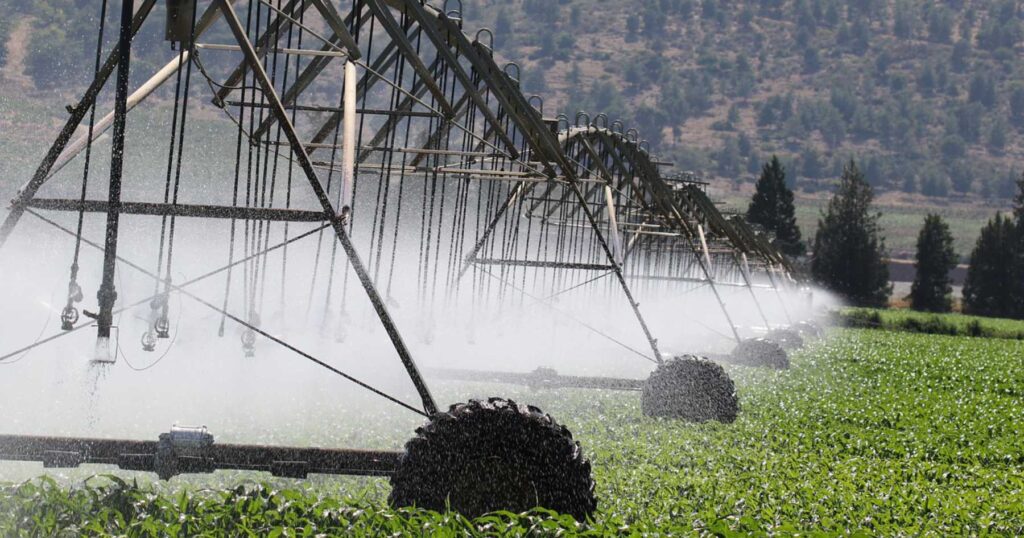
Besides the need for large quantities of feed, animal agriculture requires more water across the supply chain. Farm animals are often housed in large, intensive livestock facilities, or factory farms. These farms require a lot of drinking water for the animals and water to clean and disinfect the facilities.
To get from feed to animal to an edible product, there are various processing and transportation steps that also use a lot of water.
2. Animal agriculture pollutes water resources
In addition to water consumption, animal agriculture has a large grey water footprint due to pollution. This threatens biodiversity, the environment, and human health.
Eutrophication
The large amounts of feed crops are often grown using synthetic fertiliser or manure. Fertiliser and manure are rich in nutrients that help plant growth, including nitrogen and phosphorus. These nutrients end up in surrounding waters where they cause excessive growth of plants such as algae. This is called eutrophication.
Algal blooms can cover a large part of the water surface and block sunlight from reaching aquatic plants. These plants can no longer perform photosynthesis and will die and decompose. Limited photosynthesis and bacterial decomposition deplete oxygen from the water. This lack of oxygen can cause suffocation of aquatic wildlife such as fish and other species.
Eutrophication happens in freshwater resources and in salt water where it affects coastal waters and marine biodiversity.
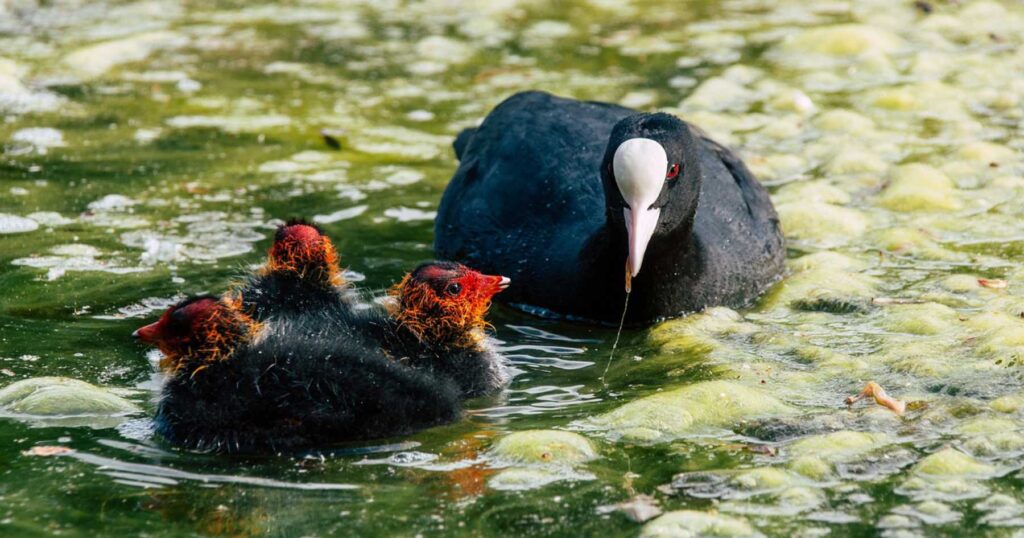
Other pollutants
Besides nutrients, waste from livestock and fish farms also contains medicinal residues such as antibiotics and hormones. These are used to promote growth and prevent disease. Animal feed can contain heavy metals that end up in manure. These pollutants also end up in slaughterhouse waste. Additionally, crop growth depends on pesticides that kill a broad range of organisms.
These chemicals run off into waterways surrounding livestock and fish farms. Here they harm plants and animal species, impacting aquatic biodiversity. Pollutants may also end up in our food and drinking water and directly affect human health.
Antibiotics are particularly dangerous because they can lead to the development of antibiotic-resistant bacteria, which pose a serious threat to human health.
3. Indirect effects of animal foods on water supply
The large amount of land used for meat and other animal products has some indirect consequences for freshwater availability. These indirect effects are not considered in the water footprint of a product but have a significant impact on global water supplies.
Land use
Land use for grazing or feed crops removes natural vegetation, which leaves the soil exposed to wind and water erosion. Runoff of sediment from eroded soil can clog, pollute, and destroy freshwater ecosystems.
Trees, plants, and soil vegetation capture fresh water and serve as a natural reservoir that provides a stable water supply to the environment across seasons. Forests even store three-quarters of fresh water on Earth.
Because 77% of all agricultural land is used for livestock farming, it is also a major driver of deforestation. Removing trees and plants for agriculture disrupts the global freshwater cycle and reduces the availability of fresh water for the environment and crop growth.
Climate change
Our food system is responsible for one-third of human greenhouse gas emissions. Animal food products emit 57% of those and plant-based food only 29%. So, animal agriculture is a disproportionately large contributor to climate change, which threatens global water supplies in several ways.
Global warming and more frequent heatwaves increase evaporation of water from soil and freshwater resources. This causes droughts and water scarcity with devastating consequences for the environment and societies.
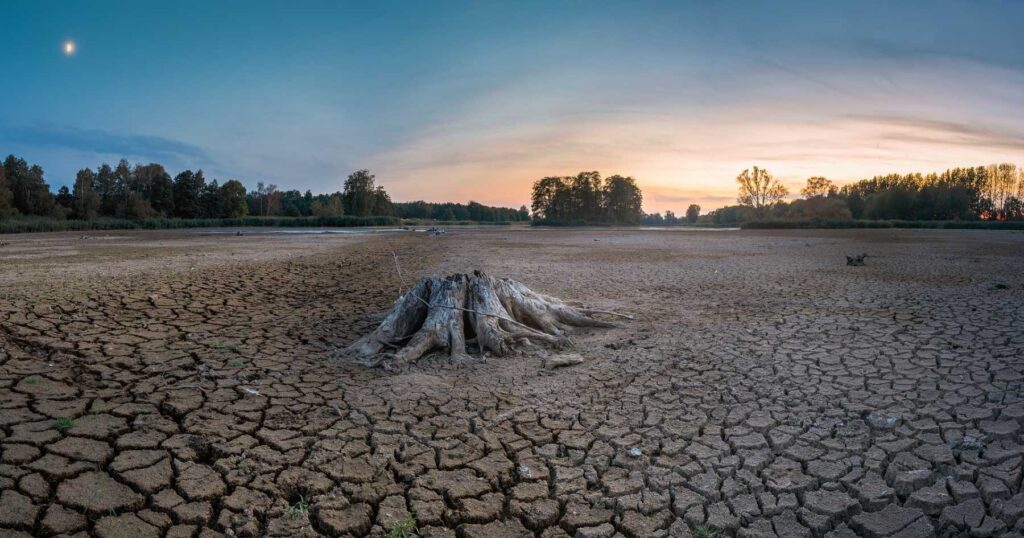
On the other hand, higher temperatures increase water vapour in the atmosphere, which leads to heavier rainfall and storms.
Higher precipitation in a short period increases the risk of floods, which are already occurring more often due to climate change. Floods can pollute drinking and irrigation water and contribute to spreading of infectious diseases such as cholera.
Unsustainable land use increases the risk and severity of flooding due to loss of stabilising vegetation and reduced water buffering capacity.
Snow and ice are important water buffers and freshwater reservoirs that provide fresh water throughout the year. Global warming reduces ice and snow covers, affecting ecosystems and people that depend on meltwater supply.
Rising sea levels due to thermal expansion of oceans impact groundwater through salinization.
The Water Footprint of Meat and Other Foods
Now that you understand why animal agriculture has a high impact on water supply, let’s take a look at the actual water footprint of some food products. Mekonnen and Hoekstra did an extensive analysis of the green, blue, and grey water footprints of several food products as shown in the chart and table below.
Beef has the biggest environmental impact in general and also the highest water footprint. It takes over 15.000 liters of water to produce 1 kilogram of meat from beef cattle. This is equal to 250 showers.
Beef uses 50 time more water per kilogram and 20 times more water per calorie than starchy roots such as potatoes. So, you can already greatly reduce your water footprint by avoiding beef or any red meat.
The data also shows that among plant-based foods there are substantial differences. Although nuts have a low environmental impact on other areas, their water footprint is particularly large due to dependance on irrigation.
So, if you need to choose between types of plant-based milk, avoiding the ones made from nuts such as almonds can lower your water footprint.
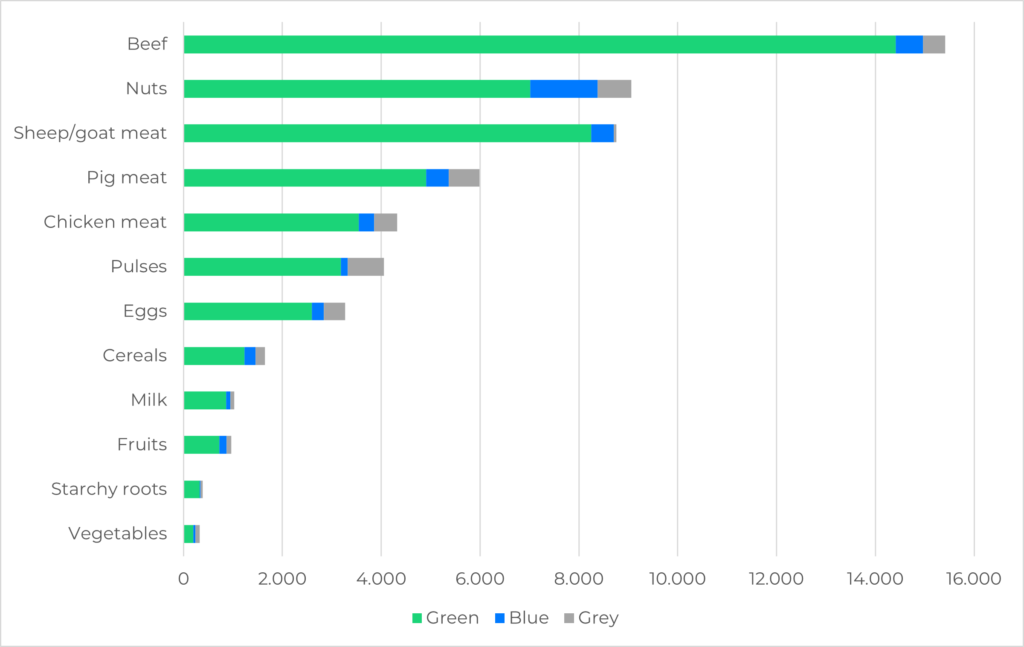
Green, blue, and grey water footprints of foods in liter/kg product, including different types of meat and plant-based foods. Adapted from Mekonnen and Hoekstra, 2012.
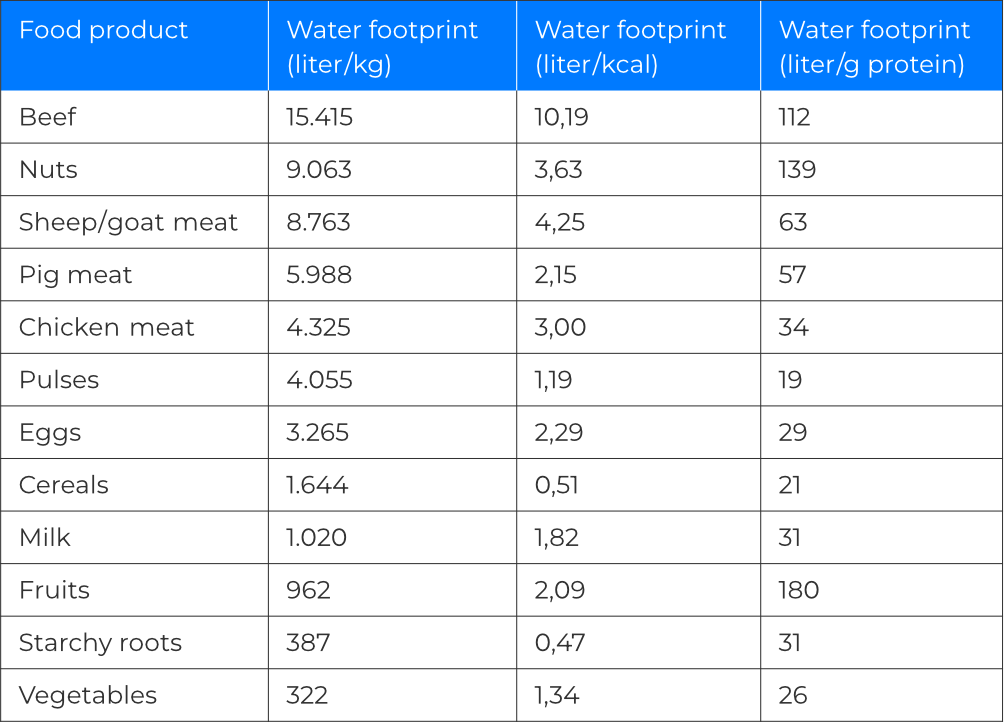
Total water footprints of different animal and plant-based foods, per kilogram, kilocalorie, and gram of protein. Adapted from Mekonnen and Hoekstra, 2012.
Adopting a Vegetarian or Vegan Diet Saves Water
Water is essential for life and a natural resource we should treat with care. Unfortunately, water supplies are under severe pressure and the global water crisis is becoming more urgent.
The main reason for water shortages is the high environmental footprint of our lifestyles and associated climate change. Reducing household water use such as taking shorter showers is important to save water. However, to truly protect our water resources, we must change our diets.
Our food system is the main consumer of water and the prospect of growing from 8 to 10 billion people by 2050 means we will need to produce even more food.
We therefore need to revisit what we eat and shift to sustainable agricultural practices. The production of meat and other animal products has an excessive water footprint, mostly due to its inefficiency. A global shift to vegetarian or plant-based diets is essential to conserve water.
By adopting a vegan diet, you can reduce your food water footprint by 54% and eutrophication by 73%. Even a vegetarian diet already reduces your water footprint by 39% and eutrophication by 57% compared to a meat-heavy diet.
Besides lowering your water footprint, a primarily plant-based diet will benefit the environment in several other ways, including reducing climate change.
You can calculate how much water and eutrophying emissions you save with your diet by downloading our free app.
Inspire others by sharing this article!
Track Your Impact
Inspire your vegetarian or vegan food choices by calculating your impact on 22 parameters.
